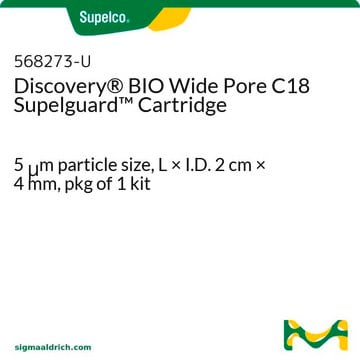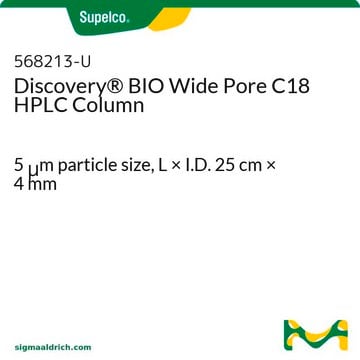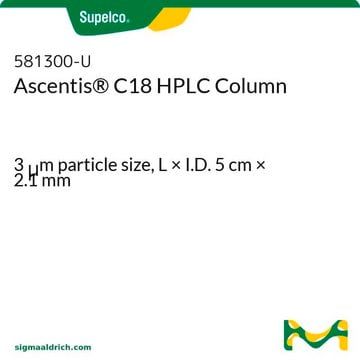Reverse Phase Column Rehydration Method:
1. The column should ideally not contain any buffer. If it does, thoroughly flush the column with water to remove the buffer.
2. Flush the column with 100% acetonitrile, starting at a flow rate of 0.3-0.5 ml/minute. Slowly increase the flow rate to 1 ml/minute, flushing for approximately 30 minutes, as long as the pressure does not excessively increase.
3. Equilibrate the column with the mobile phase specified on the Certificate of Analysis (CofA) of the column, and run a test mix similar to what was used to test the column.
4. If the performance is unsatisfactory, repeat the method, increasing the flushing with acetonitrile for one hour.
5. Repeat the test. If the performance is still not as expected, the column may have degraded.
568223-U
Discovery® BIO Wide Pore C18 (5 µm) HPLC Columns
L × I.D. 25 cm × 4.6 mm
Sinónimos:
Wide Pore C18 HPLC Column
Seleccione un Tamaño
965,00 €
Seleccione un Tamaño
About This Item
965,00 €
Productos recomendados
Nombre del producto
Columna para HPLC Discovery® BIO Wide Pore C18, 5 μm particle size, L × I.D. 25 cm × 4.6 mm
Materiales
stainless steel column
Agency
suitable for USP L1
Línea del producto
Discovery®
Características
endcapped
fabricante / nombre comercial
Discovery®
envase
1 ea of
Extensión del etiquetado
9.2% Carbon loading
Parámetros
0-70 °C temperature
400 bar pressure (5801 psi)
técnicas
HPLC: suitable
LC/MS: suitable
L × D.I.
25 cm × 4.6 mm
superficie
100 m2/g
cobertura de la superficie
3.6 μmol/m2
Matriz
silica particle platform
fully porous particle
grupo activo de la matriz
C18 (octadecyl) phase
tamaño de partícula
5 μm
tamaño de poro
300 Å
pH operativo
2-8
técnica de separación
reversed phase
¿Está buscando productos similares? Visita Guía de comparación de productos
Descripción general
Aplicación
- Kinetic performance comparison of superficially porous, fully porous and monolithic reversed-phase columns by gradient kinetic plots for the separation of protein biopharmaceuticals.: This study provides a detailed kinetic performance comparison of different types of reversed-phase HPLC columns, including the Discovery® BIO Wide Pore C18 HPLC Column. The research highlights its efficiency and resolution in separating complex protein biopharmaceuticals, making it a valuable tool for analytical chemists in biopharmaceutical analysis (Jaag et al., 2022).
- RP-LC x RP-LC analysis of a tryptic digest using a combination of totally porous and partially porous stationary phases.: This paper investigates the use of reverse-phase liquid chromatography (RP-LC) with both totally porous and partially porous stationary phases, including the BIO Wide Pore C18 HPLC Column, to analyze tryptic digests. The findings demonstrate its robustness and high resolution in proteomics applications, enabling precise peptide mapping and protein characterization (Mondello et al., 2010).
Información legal
Aplicación
cartucho de precolumna
Elija entre una de las versiones más recientes:
¿Ya tiene este producto?
Encuentre la documentación para los productos que ha comprado recientemente en la Biblioteca de documentos.
Los clientes también vieron
Contenido relacionado
DiscoveryBIO Wide Pore C18 products offered by Sigma-Aldrich.
Chromatograms
application for HPLC-
What is the method for rewetting a column that may have dried as a result of the end cap being loose or not being used for an extended period of time?
1 respuesta-
¿Le ha resultado útil?
-
-
WHIGH SOLVENT USED FOR WASHING OF COLUMN
1 respuesta-
See below for a general cleaning protocol:
1. Reverse the orientation of the column
2. Flush for a few minutes, or >1 column volume, with a 20% solution in water, of the organic used in the analysis, such as methanol or acetonitrile. This is to remove any residual buffer salts.
3. Flush for approximately 30 mins, or >10 column volumes, with 100% of the organic solvent used in the analysis.
4. The column can be stored with this organic solvent until ready for use.
5. Before reusing the column, flush again, as per step 2.¿Le ha resultado útil?
-
Filtros activos
Nuestro equipo de científicos tiene experiencia en todas las áreas de investigación: Ciencias de la vida, Ciencia de los materiales, Síntesis química, Cromatografía, Analítica y muchas otras.
Póngase en contacto con el Servicio técnico










